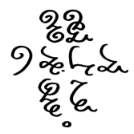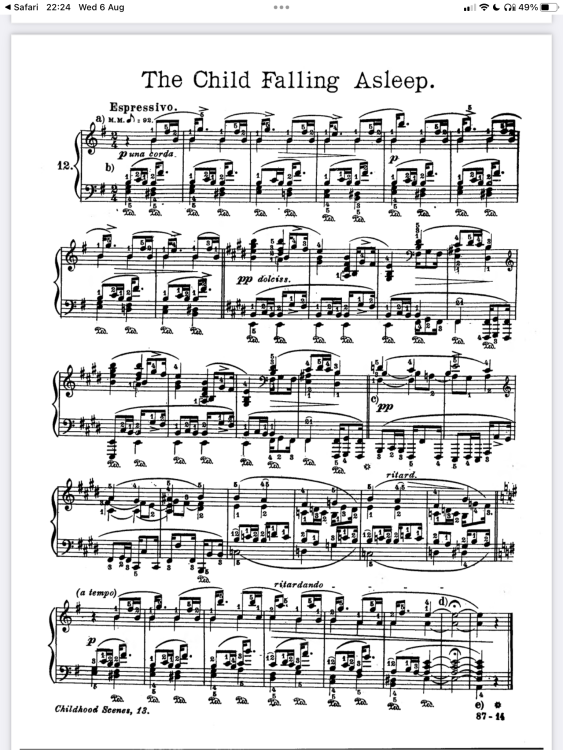Leaderboard
Popular Content
Showing content with the highest reputation on 08/06/2025 in all areas
-
I finally present to you a movement from my big variations project that I've had brewing since early 2024! Emboldened by the success of my "Deck the Halls" Variations I sought out more popular themes that I could write variations on. Originally I only intended to write variations on the Returner's March, but it soon grew out of all proportion when I started noticing all the little motivic relations between different themes so I had to include more. This is meant as a hybrid variations fantasy, medley, and mash-up of the themes that you can listen to here: The original themes were written by the great Nobuo Uematsu so my variations retain a certain Japanese flavor. In fact the first half of this Scherzo is subtitled "Asiatic". The Scherzo proper doesn't start until 6:01. I welcome any of your suggestions, critiques, comments or just observations. Thanks for listening and I hope you enjoy! P.S.: I'd like to thank my friends @chopin, @Henry Ng Tsz Kiu, @Thatguy v2.0 and @gaspard for their time, advice, and support throughout the composition process!3 points
-
Symphonic Fantasy... is there a way to add "final" to that somehow? Or would that be cheesy lol Wow, I love this so much. It really felt like a story was being told. Not necessarily the story of the game, but one you wrote with all it's themes. There just seemed to be great care in when and how variations were played out. I'm no orchestrator, but your orchestration seemed spot on and colorful, full of craftsmanship and creativity. I really liked the section of just winds, or the moments of trem strings. Even though you have cadences and breaks in the music, it never felt like it was dragging or boring. Your writing really had a sense of blurriness with collage-type textures when you wanted it too, and then was bold and clear during other times. I just love the diversity with instrumentation, dynamics, range, color, you name it (maybe techniques too?). The bass guitar and synth were really cool additions, and helps set your music apart in it's style and persona. I'm not sure about all the themes, but one thing I thought about was that the themes weren't always introduced in a stately way. Wasn't a big deal, but for instance with as much motivic exploration you did with Terra's theme, I kept waiting for it to be played with the 3rd 16th note in that motif to be played on beat 1. You had such a good lead up for it, but maybe that's just a style-choice-difference we have. Your path gave it more of a fantasy vibe, which I guess is fitting for a Final Fantasy piece, eh? 😛 I didn't see it, but it would be cool if you referenced all the rehearsal marks to we could see what you were going for too! I'm to know how you organized 8 themes into a cohesive quagmire woven so well. Awesome music! I loved the build up to the Kefka moment at the end. I think it's always wise to save one of the coolest moments for the end; it makes me want to listen to the whole piece with a relisten just to get to that part again. Well done Peter, this was great! Are there more movements for the future? I think it stands alone, but you probably have so many options with variations you could keep going haha2 points
-
The basic framework for this canon has been in the works for more than a month now, as the technique I employed in the latest one in order to have all voices enter in every diatonic transposition of the same motif turned out to be contrapuntally insufficient. This time, in order to account for more viable ranges both in instrumental and choral settigs, I reduced the number of voices to 6, even though the core parameters still remain: every voice enters one fifth below the previous one, and instead of diatonic transpositions being treated as though in the same key, every transposition is essentially a real answer throughout, with the integrity of the main theme's melodic intervals kept intact. This entire setup (alongside certain variations when it comes to the disposition and order of entry of each voice so as to accommodate for the instrumental and vocal ranges of the woodwinds and the choir respectively) gives rise to a distinctly chromatic environment of constant modulation leading to a 2nd iteration of the same canon one tritone higher, at which point it keeps rising to meet the octave above and every voice alternates a divisi to prevent the melodies from climbing even higher and thus, yielding a perpetual canon (with a coda at the end for good measure). Lastly, the lyrics in Latin sung by the choir are intended as placeholders with thematic and allegorical significance towards the spirit of the canon itself: "Rosea surgit aurora, Sol fulget in caelo - Aurea cadens vesper stellarum tegit noctem", which would roughly translate to "Dawn rises rosy, the Sun shines in the sky. Evening falls golden, covering the night in stars." Not profound by any means, but simple enough to reflect the perpetual motion of the canon as an allegory for the unending passage of time. YouTube video link:2 points
-
Hey @Uhor! Thanks to you sharing this composition I realized we're both in the same early music server! I like how you create a rich but oddly calm soundscape in the beginning, only for it to turn more and more menacing as the piece progresses. At first you introduce the night, and the moon. Then the sun rises and creates desolation, even though it is also the giver of life. Your music seems to be a celebration of mostly diatonic dissonance. I like the brass chordal scalar runs up and down around 8:30ish. The music builds through a slow accelerando increasing the momentum. But it doesn't lead to a climax but instead dissipates back down. Around 14ish the music arrives at a big sustained dissonant chord. But it's not overly dissonant, retaining some pan-diatonicism, with the ebb and flow of passing solo Trumpet scales and Trombone counterpoint. Very interesting soundscape - thanks for sharing!2 points
-
Haven't really written anything in quite some time, but I felt like writing this after imagining the melody. The choice of hymn was arbitrary (just something I already knew), but it was really easy to set to music.1 point
-
Hi to all. I'm pleased to present my latest attempt at orchestrating a piano work. I've extended the piece, and added some of my own touches, including extra counterpoint lines. Haven't spent much time on it yet: so I'm sure I'll need to revise some things. Hope you enjoy!1 point
-
It took me days and hours but this poem is finally presentable. It's meant for a virtual orchestra, because its so huge. The literal poetic guide is in the description of the video, though it was written after-the-fact.1 point
-
This is the fourth and final movement of my Violin Sonata in B flat major, commissioned by and dedicated to Arjuna Clark (lately Archie) @expert21. This movement is in Variation form which is my first attempt on the form in a movement, though I already use quite some variations techniques in my old pieces. I choose the form because rather than another narrative sonata form movement, a variation movement exploring the possiblities of the ARJUNA motive is much more appropriate for me. Again, thx to @Thatguy v2.0 for making the audio. I try for some strict procedure in each of the variation, as I use Prime and Inversion form of the ARJUNA motive for the 1st half of a variation, then Retrograde, Retrograde-Inversion and Prime form of the ARJUNA motive for the 2nd half of a variation. Even though the motive itself is short and easy enough to achieve this kind of treatment, still I wanna use them for coherence. Because of this, this one is probably the hardest movement in this Sonata to write with. Here is the YT video and pdf scores of the movement: Violin Sonata in B-flat major 4th mov.pdf Here is the structure of the movement: 0:00 Thema: Allegretto Commodo. A rather simple and easy-going theme for later variations. 1:16 Variation I: Allegretto con moto: A funny variation. Introduces G-flat major for the 1st time in the movement. In the second half, each two bar phrase is the retrograde of the two bar phrase corresonding to the first half, e.g. b.26-27 correspond to b.17-18. 2:13 Variation II: Allegro con energico. A variation heavily inspired by the 2nd movement of Beethoven's Razumovsky Quartet no.1, which is also in the same key. End of the 1st part and begins 2nd part with variations begins in different keys. 3:03 Variation III: Andante Comtemplativo. A variation begins in D major and makes chordal usage of the ARJUNA motive. Briefly reintroduces the 2nd movement theme in 4:04. Ends with a dark transition to C sharp minor. 5:08 Variation IV: Adagio Doloroso. A variation begins in C sharp minor. I make use of the Beethoven op.135 theme again as in the 3rd movement, but this time in minor mode and all sorts of dissonances, since it reflects the dark mood I was having then. The use of ARJUNA motive is saturated here; I even use all four forms of the motive together in b.110. Ends in Picardy third and modulates to the next variation. 6:44 Variation V: Andantino con moto e tranquillo. A variation begins in G-flat major and modulates through D major before returning to tonic B-flat major. I quote a lot of pentatonics and quartals here to show the influence of my String Sextet. 8:10 Variation VI: Fugato e Coda: Allegro Vivace, con brio e energico. Even though it 's a cliche to end a variation in a fugato, I still use it here nonetheless. The fugue subject makes use of the prime and inversion form of ARJUNA motive, while the countersubject the retrograde and inversion of the motive. The episodes also make use of the motives too. I even quoted my Clarinet Quintet main theme in 8:47. Waltz rhythm gradually returns and polyphonic texture changed to a homophonic one, just like the ending of Beethoven's op.110 Sonata. More affirmations of the ARJUNA motive comes and ends the music in a high energetic way. I quite enjoy the ending not to lie. Thx for listening and hopefully you will leave some comments here! Henry P.S. Here are the previous movements posted on YC forum: 1st Mov: 2nd Mov: 3rd Mov:1 point
-
I don't have much to do with cover tunes or video game music these days, but with new Ninja Gaidens and Shinobi games coming out, it appears 2025 is indeed the year the ninja master returned. I have better gear than they did back in '93, so I arranged the theme from Shinobi 3 in the '80s martial arts film score style I believe they were going for on that old Sega soundchip!1 point
-
Hey Peter, Thanks for the warm words! The original does actually have the subdominant ending (see attached). My new counterpoint is mostly in bars 45-51, in the oboe and clarinet. I did think I might add some glissandi in the harp, as the harpist doesn't have much to do here, and it might suit the mood of the piece. Hopefully I don't have any wrong notes like I did in the Debussy!1 point
-
Hey @Alex Weidmann! I really love this piece! And your orchestration is great! I usually like when composers try to end their music on a non-tonic chord. And one of my favorite moves too is to end on a subdominant, which you do here. But I think, the tonic is so well established here and repeated so much that it seems unnatural for it to end on the A minor chord. But I like the overall ending idea - not sure how much of it is your personal addition and how much is in the original. And the counter melodies I liked too! You also keep the groups of instruments playing together relatively small at any given time, giving the piece that chamber feeling that it needs in this case. Thanks for sharing - your orchestration skills are definitely improving!1 point
-
1 point
-
Oh I'm sorry, I totally forgot this time... And it was too late to correct. I will therefore submit a translation here (let's say you will have an overview of the text without necessarily having the correspondences, but there are several games that I had fun making to match text and music... There is even a quote from Fauré's requiem towards the end...) In any case, thank you and thank you again for listening. It makes me very happy... Litanies of the First Quarters of the Moon Blessed Moon Of sleepless swoon, White medallion For Endymion, Fossil star Exiled afar, Jealous tomb Of Salammbô’s bloom, Pier for the fleet Of Mysteries deep, Madonna and miss, Diana–Artemis, Holy watchtower Of our dark hours, Jettatura For games of Baccarat, Very tired dame Of our rooftops’ shame, Potion to stir The firefly’s blur, Rosette and dome Of twilight psalms, Fair cat’s-eye light Of our last rites, Be the Ambulance Of our lost faith! Be the eiderdown Of the Grand Pardon!1 point
-
Hey @Henry Ng Tsz Kiu! I don't know how I haven't yet mentioned this but I like how the main Arjuna theme is a clever set of enclosures around a single tone. By approaching a tone by both overshooting and undershooting it with a leading tone from below you create a nice sense of approaching the tone from all directions. I love the romanticism of Variation III with its minor subdominant. Variation V takes up your now characteristic play with pentatonic scales. The fugato variation is brisk and full of vitality and life which brings the movement to an exciting and energetic conclusion! Thanks for sharing!1 point
-
Hi @Henry Ng Tsz Kiu I really enjoyed listening to the first four movements : sounds are awesome, melody pleasant and the writing very subtle. About the last two movements, I guess the writing becomes a litlle bit too complicated to my taste. Congratulations for this piece 🙂 Regards1 point
-
@PeterthePapercomPoser Thank you for taking your time and that fantastic review!1 point
-
Hiiii! I'm writing a new piece trying to understand scriabin's works and style! As this style turned out being really hard to mimick, i wanted to share the first bars (that settle the atmosphere and style of the whole piece) before continuing. There are parts i still need to fix, like bars 5 and 6, that ara just "meh" and feel a bit out of place. What do you think???1 point
-
Hii! @PeterthePapercomPoser Noo, it's not me, its muse score who is playing it! A tried to make it sound as real as possible but i couldn't program the rubato and tempo shifts hahaha The purple notes is the main motif!1 point
-
@PeterthePapercomPoser @FILMSCORE @Uhor @BipolarComposer I know it's been a while. I haven't been here in a hot minute. But a lot of things were reworked with this score, should you feel the want to revisit it 🙂1 point
-
I loved every bit of this! And you know, I couldn't place it before but the first half of this piece I get A Link To The Past vibes. Not so much the intro (which is awesome), but once we get to 1:18 or so. Then the second half of the piece sounds more like FF territory. Overall I like how you keep this pretty much in key, but at the same time are able to keep it harmonically interesting. You also seamlessly merged these variations into one big movement, despite their different mood changes. The biggest mood changes to my ears seemed to happen towards the later sections (and of course when you change it up to the Scherzo). But another notable change was around 10:30, which sounds like a waltz to me. This is a very cool section! I also feel like you ended with a romantic flair, which to me, is another big mood shift!1 point
-
Although microtonal, this piece was intended to be a little more palatable harmonically. I use 1/6th and 1/3rd tones so I guess technically it's 36 tet. The microtonal adjustments were only applied to the underlying harmony rather than the melodic voices so it could also be considered poly-microtonal (12 tet and 36 tet together). But I consider the microtonality in this to be really "lite", but let me know what you think! I also kinda was thinking of this as a VGM track rather than a concert-piece although I guess it didn't really end up that way. I'd appreciate any of your suggestions, comments, critiques or just observations. Thanks for listening! Edit: I've included a version of the piece with syntonic commas instead of 1/3rd and 1/6th flats/sharps. This should better approximate justly tuned 3rds in this piece. Also - my comments about the piece being in 36tet no longer apply in this version (#2).1 point

.thumb.png.8b5b433a341551e913a34392660bc95b.png)







.thumb.jpg.e5f26b712b4f9622f521b10d8a53c6d6.jpg)
